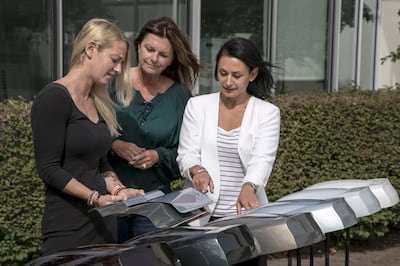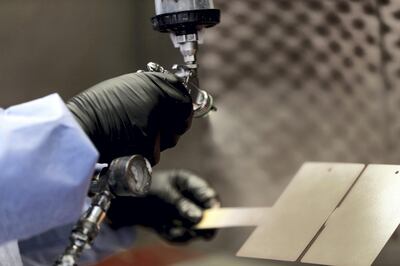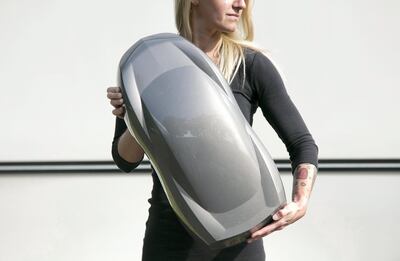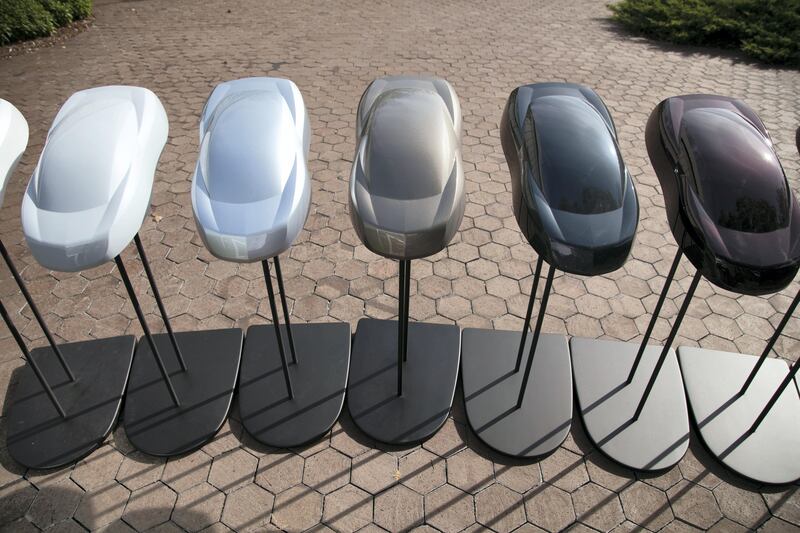Four years ago, designers from General Motors decided that the colour for select models released in 2017 would be green.
It was not a decision made over an early morning departmental meeting. It took time, with team members travelling around the world attending fashion catwalk shows to trade events for interior design.
Sharon Gauci, GM’s director of global colour and trim design, says her team works three to four years ahead of a vehicle’s production debut, on multiple years at one time. “It is an interesting parallel to release a colour collection for the coming model year as we are designing colour that will debut in 2021,” she says.
The 30-member team, ranging in design backgrounds from fashion to interior and industry, begins with researching what is happening in various sectors. Ms Gauci notes “hints of greens” in 2013 as a micro trend. “It went from fashion to interior design. It’s really exploded in terms of the hue itself."
But that does not mean a green car will be a big hit world-over.

“Green is a strong trend, but it isn’t a colour appropriate for our China customers,” Ms Gauci says. However, it could be an influencer of colours developed for use in other markets. The new "bronze dune metallic" Cadillac offer in the Middle East market has a slight green cast in the sunlight, for example.
And car colour is big business for a small number of firms. “Global automotive coatings market competitive landscape is consolidated with top four manufacturers including PPG Industries, AkzoNobel, Axalta Coatings, and BASF accounting for more than half of the overall demand,” says a report by Global Market Insights.
The researcher MarketsandMarkets estimates the global automotive paints sector will be worth US$11.34 billion by 2018. But opinions are mixed, Lucintel forecasts the market to be worth $18.2bn by 2019, while Global Market Insights predicts it will be worth $28bn by 2022.
The amount of paint sold in tonnes is set to rise from 3.8 million in 2015 to 5.5 million in 2024, according to Ameri Research.
Colours also have an emotional connection. “Colour choice doesn’t just reflect your personality, it also acts as a reflection of the circumstances around you,” says Emily Lai, Ford Motors' colour and materials design manager.
After the 2008 financial crisis, buyers were more concerned about the resale value of a car given the economic uncertainties at the time. This drove conservative colours to be the top choice in vehicle sales.

The vast majority of products bought, including cars, have been created with the help of predictions from international trend forecasting agencies which began working on them years before the finished products came to the market.
“I get to travel a lot and basically spend my days thinking, writing and talking about the future,” says the colour forecaster Victoria Redshaw, the founder of Scarlet Opus, a UK-based trend forecasting company. She graduated with a degree in textile design and spent six years in the industry as a designer for manufacturers who supplied home products to high street stores throughout the UK.
_______________
Read more:
Rolls-Royce reveals new collection inspired by Sheikh Zayed and the UAE – in pictures
Robot enabled cars make driving more dangerous
GM's second-quarter earnings drop on restructuring charges
_______________
Buyers seemed hungry for information about what products they should develop for the next season, she says. “It got me to thinking about forecasting and how the skills used in the fashion industry could be translated for use within the interiors sector,” Ms Redshaw says. And in 2003, Scarlet Opus was founded moving from a one-woman show to a team of 10.
“Colour is usually the first thing you notice about a car and it has a big impact on how a car is perceived. It is a core component in our forecasts. Everything pivots on the colour palettes,” she says.
The Scarlet Opus team analyses this information while taking into account current global events and issues. The members discuss architectural projects, hotel openings, film productions, museum shows and a myriad other events due to take place over the next two to five years. “We are essentially aiming to predict how all of this will affect people’s wants, needs and desires. It’s a fascinating process that I’ve come to think of as a social science,” Ms Redshaw says.
Customers ultimately choose what colours are used. Ms Gauci says that 80 per cent of exteriors purchased globally are neutrals, such as black, white, silver and gray. However, that number is decreasing, particularly with silver. “Customers are moving away from silver and into complex grays or choosing different ones altogether like dark navy or even maroon,” she says.

This may be attributed to the new, more expressive interiors that are also taking shape. How the interior and exterior harmonise is based on how the customer wishes to express themselves, she adds.
Mercedes-Benz says it chooses colours based on “elaborate and consistent research that keeps us updated about customer preferences”. However, the most important element for the German automotive company is to reflect its brand.
“At times, we also take a leap of faith and offer something that is radical, iconic and unique - as we believe uniqueness will ultimately drive admiration and demand,” says Lennart Mueller-Teut, the head of marketing at Mercedes-Benz Middle East.
This is seen in its new paintwork, officially named “AMG green hell mango”, for the latest Mercedes AMG GT R, a 577hp, 4 litre V8 sports coupe. “Customers of our AMG performance models are generally more adventurous and bold with their selections,” he says.
Customers in the Middle East prefer bright colours with white as the top choice, followed by silver, according to Toyota.
In the UK, the most popular colour for the four years to 2016 has also been white, says the trade journal AutoExpress, although registrations for cars of that colour declined last year by 2 per cent, meaning the second-placed black, up by 6.5 per cent in registrations last year, may take the crown this year.
Globally, Axalta Coating Systems' 64th edition of its Automotive Color Popularity Report revealed that last year, for the sixth consecutive year, white led in terms of popularity. At 37 per cent worldwide, it was up two full percentage points from 2015. Asia favours white more than any other region; at a 48 per cent, white appears on almost one of every two vehicles there. In Japan, pearl white is most popular at 27 per cent.
However, in terms of bold colours, North America is the most popular region for red (10 per cent), while Russia and Europe prefer blue (each at 9 per cent). Yellow/gold is again most popular in Asia (4 per cent).
Mercedes says palettes are chosen for various models based “mainly on market demand and need” with the colour design team constantly eyeing global trends to understand the evolving needs. But what happens if a new trend crops up suddenly?
“Car manufacturing is an exhaustive process with all the steps intrinsically connected to one another, leaving limited room for last-minute changes,” says a spokesman for Toyota.
Still, colour can make or break a car. A red Ferrari, a blue Subaru WRX, an orange Ford Mustang - they all just look "right".
"It's really about what is the appropriate colour for that vehicle. When we put an orange fury colour on the Mustang that is hot, sexy," Barb Whalen, colour and materials design manager at Ford, tells The Globe And Mail. "It is not just a colour you're going to remember. It is unforgettable.
"But if you put that colour on a [Ford] Transit or Expedition that is large and boxy, you may have an unforgettable moment that you would not feel so good about."





